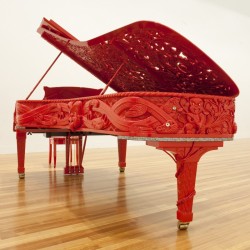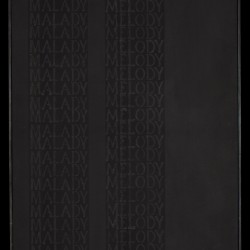Black Rainbow
This extraordinary exhibition was developed by Te Papa and features five ‘black paintings’ by the late Ralph Hotere, some of his best known works. They sit alongside Michael Parekowhai’s sculptural work, an intricately carved, Steinway grand piano, called He Kōrero Purākau mo Te Awanui o Te Motu: story of a New Zealand river.
The Te Papa curator behind the show, Megan Tamati-Quennell, says the works were brought together as a tribute to Hotere, and to acknowledge Parekowhai’s standing as a contemporary artist.
She says both artists can be described as ‘Māori Internationals’. In the early 1960s, Hotere became the first Māori artist to be embraced by this country’s art mainstream. Decades later, in 2011, Michael Parekowhai represented New Zealand at the Venice Biennale, where his cherry red grand piano was his central work.
Tamati-Quennell says “The two artists are of different generations and although both are determinedly individual, both use colours and ideas to actively engage the viewer and make the complex seem effortless.”
The public are invited to play He Kōrero as part of the artwork, and this sits in stark contrast with Hotere’s silent and minimal paintings.
“The exhibition took on a greater poignancy when Ralph Hotere passed away in February 2013, a little more than a month before it opened at Te Papa,” says Tamati-Quennell.
Black Rainbow was first shown as part of Ngā Toi | Arts Te Papa, the museum’s regularly updated programme of art exhibitions drawn from the nationalllections.
Karen Mason, an associate director at the museum, is delighted to see exhibitions from Ngā Toi | Arts Te Papa, like this one, touring New Zealand. She says “This reflects a real desire to share the country’s art treasures. Black Rainbow is a welcome addition to the touring programme, which works with museums and galleries around the country to ensure communities can connect with more of the national collections.”
Ralph Hotere
One of eleven children, Hone Papita Raukura (Ralph) Hotere was born in Mitimiti, Northland, in 1931. He was educated at Hato Petera College and Auckland Teachers’ College, before moving to Dunedin in 1952 to specialise in art.
After a spell in the Bay of Islands as an arts advisor for the Education Department, Ralph was awarded a New Zealand Art Societies Fellowship to study in London at the Central School of Art in 1961. His time in England proved to be pivotal to his development as an artist. With the art world caught in a wave of general upheaval, which witnessed the advent of Pop Art and, subsequently, Op Art, Hotere found himself both influenced by the new movements and, as an outsider from New Zealand, at enough of a critical distance from what was new andtrendy in British art to develop his own distinctive style.
Returning to New Zealand in 1965, he began to focus exclusively on his artistic career. Before being awarded the Frances Hodgkins Fellowship and moving to Dunedin permanently in 1969, Ralph had two important solo exhibitions in Auckland: Sangro Paintings and Human Rights (1965) and Black Paintings (1968).
During the same period he also struck up a relationship with the New Zealand literary world, publishing four drawings in Landfall 78 and designing the cover for Landfall 84, which was to come to full fruition in subsequent years in collaborative works with New Zealand poets.
In 1979, he used his friend Hone Tuwhare’s well-known poem Rain to produce Three Banners with Poem, for the Hocken Library. The public appeal of this, and similar works is tremendous: the 1997 exhibition paying tribute to such collaborations, Out the Black Window, opened at the City Gallery in Wellington to an impressive 1200 visitors on the first day.
In 1994 Ralph received an Honorary Doctorate from the University of Otago. He received one of the ten inaugural Icon Awards from the Arts Foundation in 2003 and in 2006 he was awarded Te Taumata Award by Te Waka Toi recognising outstanding leadership and service to Māori arts. He was awarded New Zealand’s highest honour – the membership of the Order of New Zealand – in the New Year Honours 2012.
Ralph Hotere’s work is represented in every major public and private collection in New Zealand and in art museums throughout the world.
For much of his life Ralph Hotere lived in Port Chalmers, Dunedin. He died on 24 February 2013, aged 81 and is survived by his daughter Andrea and his wife Mary McFarlane
(Credit: The Arts Foundation www.thearts.co.nz)
Michael Parekowhai
“
/* Style Definitions */ table.MsoNormalTable {mso-style-name:”Table Normal”; mso-tstyle-rowband-size:0; mso-tstyle-colband-size:0; mso-style-noshow:yes; mso-style-priority:99; mso-style-parent:””; mso-padding-alt:0cm 5.4pt 0cm 5.4pt; mso-para-margin:0cm; mso-para-margin-bottom:.0001pt; mso-pagination:widow-orphan; font-size:10.0pt; font-family:”Calibri”,”sans-serif”; mso-bidi-font-family:”Times New Roman”;} They [Michael Parekowhai artworks] have a way of sneaking up on you, even when they’re straight ahead. Pick-up sticks swollen to the size of spears. A photograph of a stuffed rabbit who has you in his sights. A silky bouquet that rustles with politics. Seemingly serene beneath their gleaming, factory-finished surfaces, Michael Parekowhai’s sculptures and photographs are in fact supremely artful objects. ‘Artful’ not just because they’re beautifully made…but also because they manage, with a combination of slyness, charm and audacity, to spring ambushes that leave you richer.”
Justin Paton, Art New Zealand
/* Style Definitions */ table.MsoNormalTable {mso-style-name:”Table Normal”; mso-tstyle-rowband-size:0; mso-tstyle-colband-size:0; mso-style-noshow:yes; mso-style-priority:99; mso-style-parent:””; mso-padding-alt:0cm 5.4pt 0cm 5.4pt; mso-para-margin:0cm; mso-para-margin-bottom:.0001pt; mso-pagination:widow-orphan; font-size:10.0pt; font-family:”Calibri”,”sans-serif”; mso-bidi-font-family:”Times New Roman”;} Michael Parekowhai was born in Porirua, New Zealand in 1968. Michael is of European and Māori descent. He graduated with a BFA (1990) and MFA (2000) from Auckland University’s Elam School of Fine Arts and holds the position of Associate Professor in Fine Arts at the University of Auckland. His exhibition history spans two decades of practice.
Michael’s narratives can be complex; he draws on an abundant range of both vernacular and collective vocabularies which he re-manufactures into the narrative structures and formal languages of his work. Although key themes of his practice could be described as deliberate takes on notions of introduced species and culture, any potentially overt political dimensions are downplayed. Ideas of camaraderie, tools of teaching and childhood learning, as well as quotes from the canon of modern art history and popular culture openly play out in many of Michael’s stories. While his work is often described as emphasising the extraordinariness of the ordinary, each body of work has layers of potential for meaning and significance – they are open to any depth of interpretation and storytelling.
Michael Parekowhai is one of New Zealand’s most important contemporary practitioners. In addition to an extensive exhibition history, his work is held in all significant public and private collections throughout New Zealand and Australia, as well as major works in permanent collections across the Asia-Pacific region and Europe. Michael Parekowhai has been included in many important exhibitions, including the Asia Pacific Triennial (2006-2007), the Gwangju Biennale (2004); Sydney Biennale (2002), Headlands, MCA, Sydney (1992); and the major art fairs in Basel, Art Basel (2006, 2007) and LISTE (2007). A major volume cataloguing Michael Parekowhai’s practice was recently published by Michael Lett, Auckland (2007). Michael’s work has been reviewed in most major international art periodicals, and covered by every major art periodical in Australasia.
(Credit: The Arts Foundation www.thearts.co.nz)


